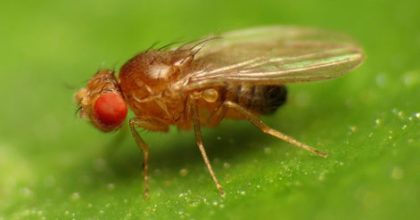
 )
)With the American Scientific Affiliation meeting coming up this week, I’ve got connecting on the brain. And now after catching up with the science news, I’m also thinking about the connections in the fruit fly brain. It was announced last week that scientists have taken a series of images of a fruit fly brain with enough detail to see every neuron. Of even greater interest is the ability to see every connection between pairs of neurons. Studying how neurons are “wired up” can provide insight into where specific sensory information is processed, for example, which might illuminate how that information is processed. As a first step, some researchers looked at the neurons connected to the olfactory system–where the fruit fly presumably detects the aroma of bananas.
The announced results represent a notable achievement on their own, and also only the beginning of what will ultimately be learned from this work. The data have been collected–no simple feat, requiring a robot to slice impossibly thin sections and a high resolution camera rapidly recording images–but analyzing and understanding what it all means is still to come. That will likely be years, possibly decades of work. There might even be a place for citizen scientists to contribute, either with their own personal effort or by donating computer cycles to an automated processing effort. (No such project was included in the initial announcement, though.) Getting to this point was already a cross-disciplinary coup, and making sense of all the data that was captured will require even more types of expertise. For those interested in how science is done, the connections between researchers contributing to the study of the fruit fly brain will likely be an illuminating data set all of its own.
You may recall a discussion earlier this year about the role of RNA in memory, based on some research in sea snails. That study was part of a body of work suggesting that synapse connections are not the only, and perhaps not even the primary, physical manifestation of memories. Of course, there are other roles for the brain besides storing memory, and memory would probably be difficult to tease out from this particular data set anyway. (How might you go about looking for a memory signature in these brain images?) Still, it will be interesting to see how this fruit fly research contributes to our understanding of the relative importance of synapses and connections in the function of the brain.
One last reminder that I will be at the ASA meeting at Gordon College this weekend. I hope to see lots of you there. Check out last week’s blog post for all the details of where I’ll be. Don’t forget that the student group with the most attendees will win 3 copies of Faith across the Multiverse, to be awarded at lunch on Saturday.
Andy has worn many hats in his life. He knows this is a dreadfully clichéd notion, but since it is also literally true he uses it anyway. Among his current metaphorical hats: husband of one wife, father of two teenagers, reader of science fiction and science fact, enthusiast of contemporary symphonic music, and chief science officer. Previous metaphorical hats include: comp bio postdoc, molecular biology grad student, InterVarsity chapter president (that one came with a literal hat), music store clerk, house painter, and mosquito trapper. Among his more unique literal hats: British bobby, captain’s hats (of varying levels of authenticity) of several specific vessels, a deerstalker from 221B Baker St, and a railroad engineer’s cap. His monthly Science in Review is drawn from his weekly Science Corner posts — Wednesdays, 8am (Eastern) on the Emerging Scholars Network Blog. His book Faith across the Multiverse is available from Hendrickson.

Leave a Reply